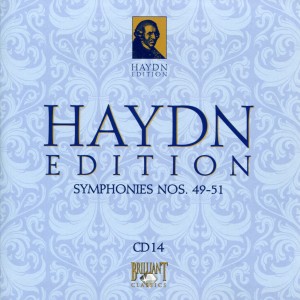 This morning, I tried something different with Haydn’s symphonies. I didn’t actively listen to them. I listened to them as background to e-mailing, researching, thinking.
This morning, I tried something different with Haydn’s symphonies. I didn’t actively listen to them. I listened to them as background to e-mailing, researching, thinking.
In other words, passive listening.
I wanted to see if something about these three symphonies would jump out at me if I wasn’t paying attention to them.
I also wanted to see if symphonies are best actively heard, or if one can enjoy them by keeping them in the background.
Even though I listened to CD 14 at least twice, and possibly three times, I discovered what one might expect I’d discover: Unless I pay attention, their nuances, even their broad sweep and expert craftsmanship, are lost to me.
I may as well be listening to the latest from Miley Cyrus.
Symphony No. 49 in F Minor “La Passione” was composed in1768. Haydn was 36.
Why it is nicknamed “The Passion” is an interesting story. According to its entry on Wiki:
As with all the other titles that have become attached to Haydn’s symphonies, this did not originate with the composer himself. It was long believed that the nickname “La passione” or The Passion derived from the nature of the music itself: the slow opening movement of the sinfonia da chiesa, its minor key modality and its association with the Sturm un Drang period of Haydn’s symphonic output. Drawing from this traditional reading, H.C. Robbins Landon has described it as “dark-hued, somber – even tragic.”
However, the nickname can be traced back to a single source from a performance given during Holy Week in the Northern German city of Schwerin in 1790, where secular music was banned from performance between 1756 and 1785. This suggests that the name was derived circumstantially and not thematically and that reading the symphony as having a Passion-related motif is post-facto interpretation.
Symphony No. 50 in C was composed in 1773 and 1774. Haydn was 41 or 42.
Symphony No. 51 in B Flat was composed in 1773 or 1774. Haydn was 41 or 42.
An interesting fact about Symphony 51, according to its entry on Wiki, is:
Sometimes described as “a concertante piece featuring the two horns, which are given parts of staggering difficulty.” The second, slow, movement contains high notes for the first horn (including an f”’ which is considered the highest note ever written for the horn) and very low notes for the second horn. Heartz has noted the character of the fourth movement as reminiscent of the French rondeau. The first contrasting section is an oboe solo in E-flat major and the second contrasting section is fortissimo and in G minor.
Because I like horns, I thought Symphony No. 51 was quite nice. But, because I wasn’t actively listening to any of these symphonies, I couldn’t separate one from another, or even their movements from within each one.
Note to self: Experiment proved Classical music is not pop music. It requires active listening to appreciate…mostly because, unlike pop music, there’s something there to appreciate.
Sorry, Franz. Next time, I’m all ears.
For now, I’ll just sit here in the sunbeam and feel all sleepy and cat-like.

Interesting about the high F for the horn. I thought I read somewhere the high note from the horn solo in The Beatles’ “For No One” was the highest note a horn could play.